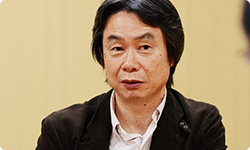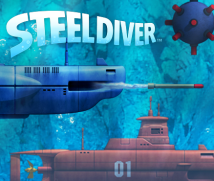5. Play on a Swivel Chair
Now I’d like to ask about the second mode, called Periscope Strike . Why did you decide to make this mode?
We made Periscope Strike because we wanted to broaden the game’s appeal so everyone could easily enjoy it.
It’s sort of like the torpedo games you used to find in arcades at the top of department stores.
The upper screen looks like you’re peering through a periscope. You spin it around, and when you find an enemy ship, you fire a torpedo and sink it.
Imamura-san, you came up with the idea for Periscope Strike after the decision to release the game as packaged software for the Nintendo DS system, didn’t you?
Yes.
How did this mode come about?

Submarines immediately call to mind periscope games, so the whole staff had always had the idea of a periscope mode. We decided to try making one, and Giles and I spent about three days making the prototype for Periscope Strike.
Giles’s work then was incredibly fast.
Yeah, really fast.
We just had an idea in our heads, but he programmed it in a flash and showed it to us right away. That was unbelievably helpful.
Actually making something is the best way to get a feel for it. And you can see everyone’s reaction right away.
That’s exactly how EAD works. See the response, then flesh it out.
I immediately had Sugiyama-san look at it. He said it was good.
So I had them polish it up. And then, when the hardware switched from the Nintendo DS system to the Nintendo 3DS system, we could make use of the gyro sensor12, so we brought that in. 12Gyro sensor: A measuring device used in attitude control to detect angle and rotation speed. Gyro has such meanings as wheel and rotation.
At first, I thought that might just be a gimmick, but when I actually played it, it felt great.
It’s perfect for a periscope that you turn around and around.
I suggest playing while sitting in a swivel chair. It’s a mode that anyone can enjoy, so I hope people who own the game will have the people around them play it, too.
I hope so, too.
The third mode is called Steel Commander . As mentioned earlier, this was Miyamoto-san’s second shot at a game like this.
That’s right.
How would you sum up the Steel Commander mode?
Remember how there used to be a board game back then? You started by lining up aircraft carriers and destroyers so your opponent couldn’t see them.
Then you had to guess where your opponent’s ships were and place pins to represent where you shot. If you hit, you could sink them.
Right. A similar game was in The Legend of Zelda: The Wind Waker13. Steel Commander is a more modern version of that. 13The Legend of Zelda: The Wind Waker: An action-adventure game released for the Nintendo GameCube system in December 2002 in Japan. The Sinking Ships game was a feature available on Windfall Island.

In those games you could only guess where to shoot, but in Steel Commander, you move your units strategically, like in chess, and search for each other’s ships. However, you can’t directly see your opponent’s units. So, for example, if you use sonar14 in your search, you’ll learn the location of enemy ships, but you won’t know whether it’s an escort or supply ship. What’s more, the moment you use sonar, your opponent learns your location. 14Sonar: A device that uses underwater acoustic waves to search for, detect and determine the range of surface vessels, submarines and other objects in the water.
Using sonar is risky. And the distance you can move is limited, so while the enemy won’t be on you right away after it finds you, you can be certain they will be closing in.
Being unable to see your opponent is unnerving. If your opponent finds your supply ship, which is important, usually you would try to run away on your next turn.
And once you locate your opponent, you might think, “I bet they’ll run,” but sometimes they don’t. Even if they do, you don’t know if it was their supply ship or not.
It might be a trap.
Yeah!
You have to watch your opponent’s face and exchange such words like, “It was just a trap, wasn’t it?” and “Maybe, or maybe not.” That kind of back-and-forth is really interesting.
You have to use your poker face. (laughs)
You can really enjoy reading each other’s hidden motives in this mode. Imamura-san and I played this mode a lot as we were developing the game as packaged software for the Nintendo DS system. We really got into it. You can also play the computer in Steel Commander mode, but there’s a special enjoyment that can’t be duplicated when you play against a real person. As long as you have one Game Card of the game, you can use the Download Play feature, so I hope people will enjoy squaring off against each other.

You hope people will watch each other’s facial expressions and enjoy tricking each other.
Yeah.
About when did you have to switch Steel Diver, which you were developing for the Nintendo DS system, over to the Nintendo 3DS system? In our last session of “Iwata Asks,” Miyamoto-san said that “it would look great in 3D.”
I didn’t tell them about the Nintendo 3DS system for quite a long time. (laughs) Not until it was almost done.
You didn’t tell them on purpose? (laughs)
Yeah. (laughs) I knew the game was perfect for the Nintendo 3DS system, but I was afraid that if we switched from the Nintendo DS system to the Nintendo 3DS system in the middle of development, the contents wouldn’t be thoroughly fine-tuned. So after the Nintendo DS version was about done, I said, “Let’s shift this over to the Nintendo 3DS system.”
When we heard that, we already had plans for debugging. Development was all but over.
Did Miyamoto-san just hit you with it all of a sudden?
I did! Although I had planned it a while before.
(to Giles) Sorry about that.
No problem. (laughs)
But I was the one who had to tell Giles! (laughs)
Yeah. I stayed behind the scenes. (gesturing as if manipulating a marionette) Like this. (laughs)
(laughs)
